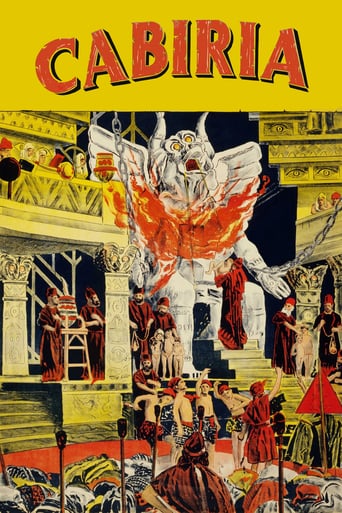



Sadly Over-hyped
Pretty Good
Memorable, crazy movie
If you're interested in the topic at hand, you should just watch it and judge yourself because the reviews have gone very biased by people that didn't even watch it and just hate (or love) the creator. I liked it, it was well written, narrated, and directed and it was about a topic that interests me.
View MoreVolcanoes, earthquakes, pirates, fire sacrifices, elephants in the Alps, camels in the deserts, ships all over the place, a heat ray, secret messages in poisoned jewelery, the first film appearance of Maciste/Hercules in a sword-and-sandal movie: what's not to enjoy? It's just unbelievable that this movie is almost a hundred years young.Well, there's a bit not to like. The first time I saw this, I spent most of the movie trying to figure out if Bartolomeo Pagano was really black. I don't think so, but am not really sure about that. If he wasn't, then it is off-putting to have a white star in black-face (in his case, 'black-body') with real black actors as extras. There's that plus some anti-Semitism, not to mention all the fascist salutes. These were the times during which the film was made.The first time around, the Moloch scene is horrifying on its own, and...***spoiler alert***...you're cheering on the heroes as they save the child. The second time around, after more thought, it's the invocation to Moloch that's so incredibly creepy against the perspective of all the young lives that would soon be offered up on battlefields throughout Europe (including Italy) in the upcoming 20th century wars.The storming of the city of Cirta near the end of the film is okay, but one can imagine D.W. Griffith sitting through it thinking, "I can do a battle-on-the-city-ramparts scene better." He did, too, with the storming of Babylon in "Intolerance." However, he didn't have Sophonisba. She makes a late appearance in "Cabiria," but...***spoiler coming up***...her death scene ends the film perfectly. And she makes another appearance at the very end. Yay!It's still an incredibly good movie, well worth watching.
View MoreCabiria is an imposing three-hour landmark classic film that offers great spectacle. The motion picture features the trials and tribulations of a Roman slave girl as the Romans battled the Carthaginians for the control of the Western World three centuries before Christ. Key movie moments include the eruption of Mt. Etna in Sicily, the sacrifice of the Carthaginian children to the pagan god Moloch, the siege of a city, Archimedes' inventions, and the crossing of the Alps by Hannibal. The famous Italian poet Gabriele d'Annunzio composed those lyrical title cards, perhaps the most famous ones in silent film history. No wonder D. W. Griffith was both impressed and inspired by the scope of Pastrone's work.
View MoreIt is a little known fact that the feature film was born in Italy - that is, a film longer than the standard one or two reels in length -ten to twenty minutes. It is the crop of early Italian features, all epics, birthed in 1914, that influenced America's Griffith and DeMille. The length of CABIRIA is staggering - originally 2-1/2 hours in Italy and just over two hours here - considering most audiences were used to sitting and concentrating on a plot for only twenty minutes at most.Were there Oscars then, the extraordinary art direction and special effects would have garnered noms - they are outstanding. The cinematography is unique in using early scanning and dollying techniques heretofore unknown in film. The plot becomes very hard to follow because the title cards are history lessons of alliances and battles that have little meaning for us and often we are aware of the cut 22 minutes in the surviving USA version as symbols and relationships which have great dramatic meaning for the players leave us baffled.The print used by Kino and Grapevine video as well as Turner Classic Movies is impeccable - crystal clear and sharp.For all fans of epic movies and for all film historians, this is a must see.
View MoreSilent films don't have much of an audience these days. Be that as it may, I would like to recommend this film as a hugely influential costume epic that had great influence over the likes of D.W. Griffith (who did Intolerence right after!), Cecil B. DeMille, and even Fritz Lang (when he did Metropolis). Sure, it's long and it's got one of those convuluted plotlines typical of the period and historically it's crap, but the sets and costumes have to be seen to be believed! The scale of things is just fantastic, with giant temples and houses, all sorts of huge rooms and decoration all over anything, and hundreds and hundreds of extras with fabulous costumes, all done in pastiche of styles that range from Egyptian to Babylonian to this whole weird Indian look, although it's all set in North Africa. Then there's the melodramatic acting, which really can't be judged by today's standards, as there are few subtitles of dialogue, only very grand and wordy intertitles summarzing the plot and offering odes to gods and goddesses. This movie is a must-see if you're studying the history of epic films, early full-length movie, Griffith, etc., and even if you're not, it's a hoot (at least until half-way through, at which point you may decide you've had enough of the plot and can guess the rest.)
View More